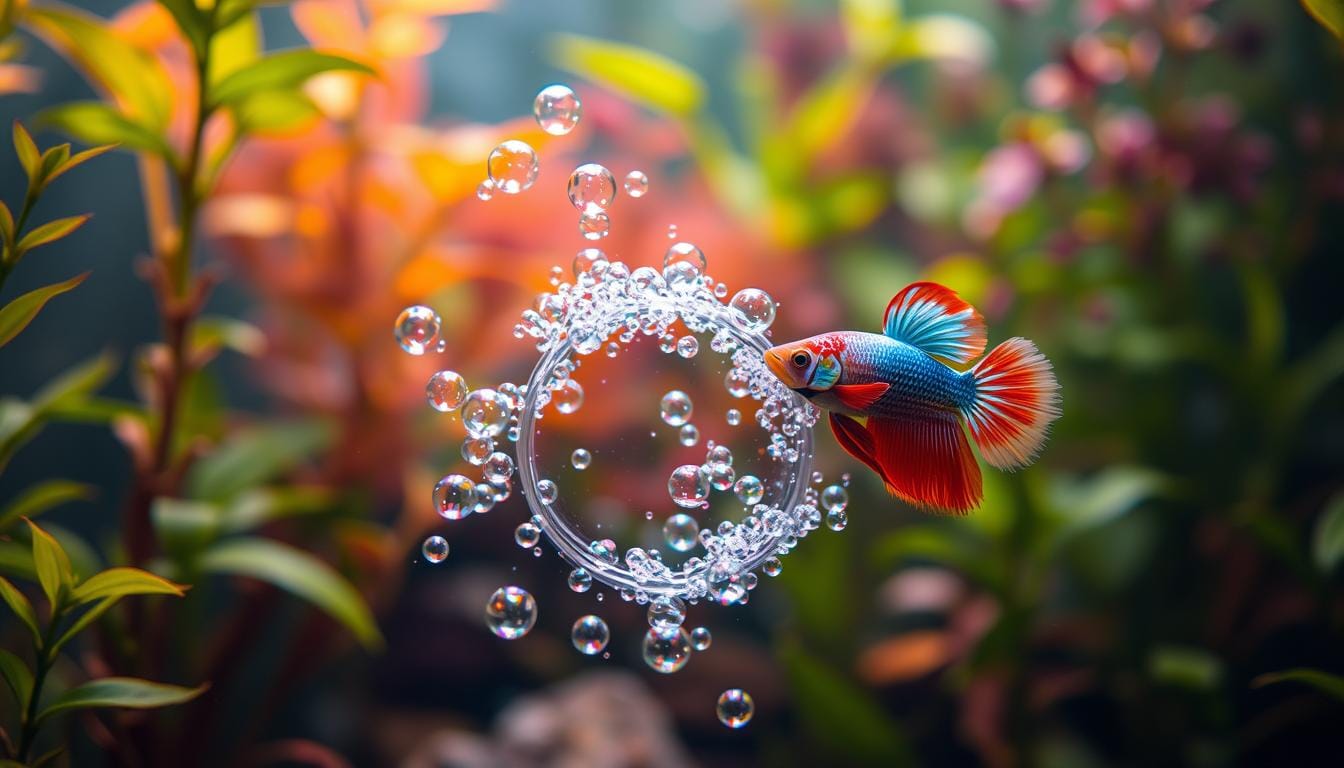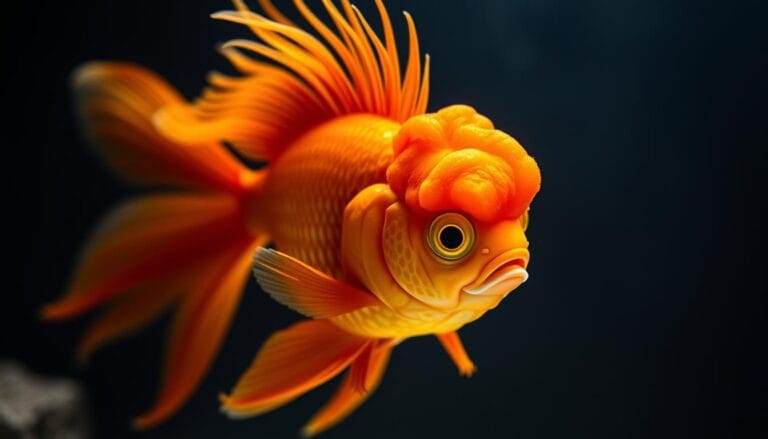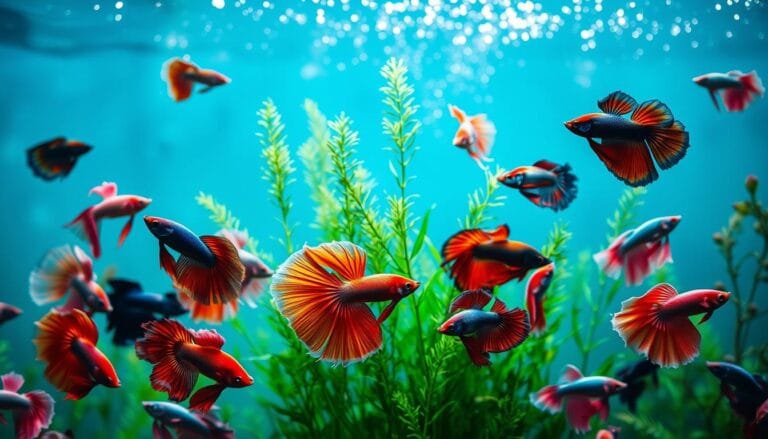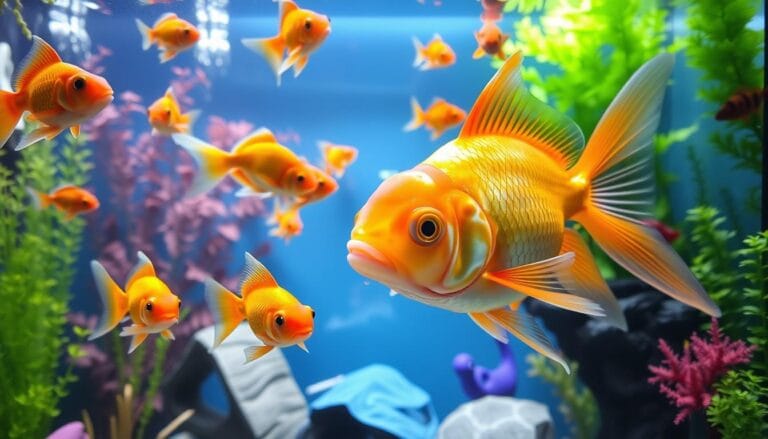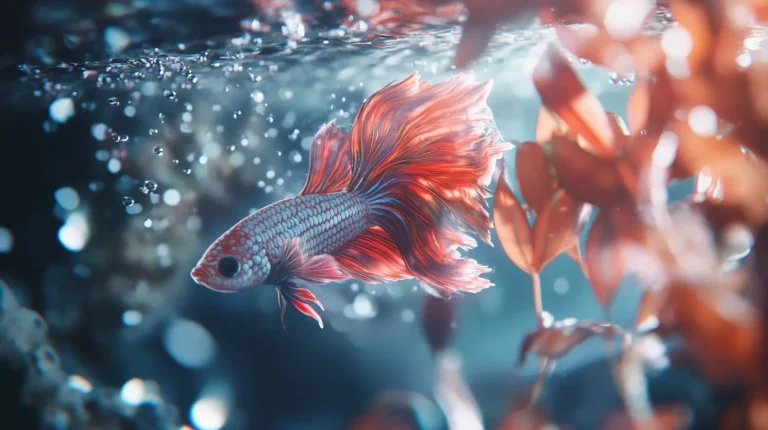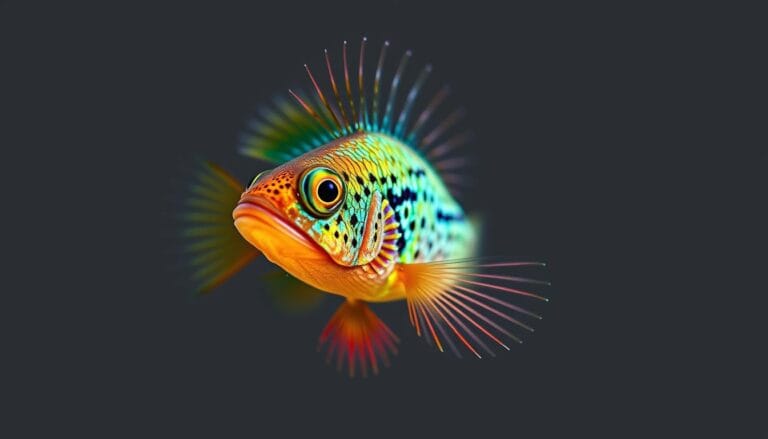Betta Fish Bubble Nest: A Guide to This Unique Behavior
Have you ever seen a betta fish bubble nest in your aquarium? It’s a fascinating sight. This structure is a natural part of a betta fish’s life, mainly for males. It’s key to their breeding.
Curious about this behavior? Want to help your betta thrive? Learning about betta fish bubble nests is a great start. It ensures your pet stays happy and healthy.
Table of Contents
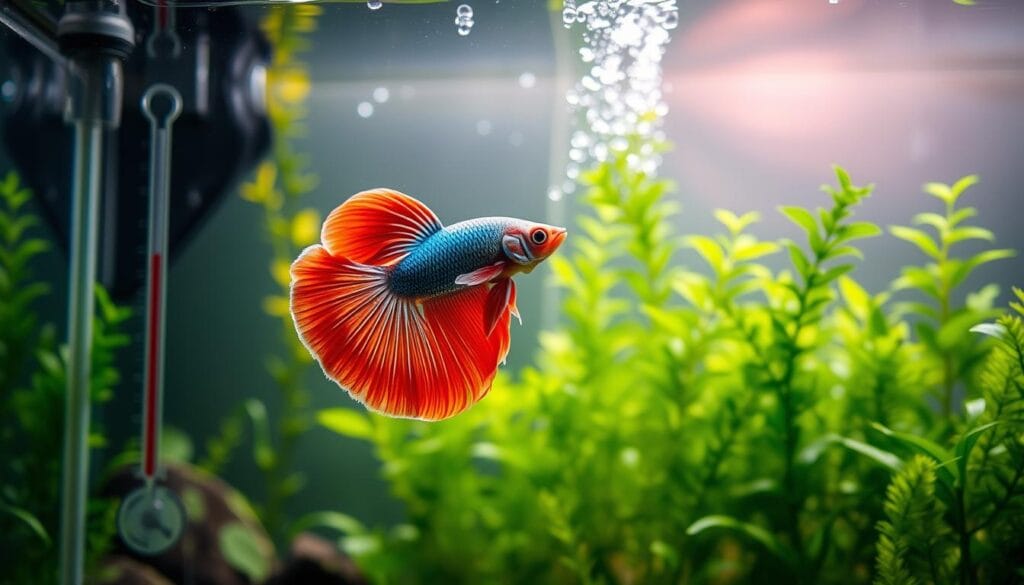
Discovering more about betta fish bubble nests opens up new insights. You’ll learn how to create the perfect environment for your betta. This includes the right tank size, water quality, and plants.
With the right knowledge, you can encourage your betta to build a bubble nest. This is a sign of a happy and healthy fish.
Key Takeaways
- Understanding betta fish bubble nests can help you provide better care for your pet.
- Betta fish bubble nests are a natural behavior, mainly shown by males.
- Creating a suitable environment, like the right tank size and water quality, is key for healthy behavior.
- Aquatic plants and stable water help with bubble nest creation and upkeep.
- Regular water changes and proper feeding are vital for a
When it comes to keeping betta fish, understanding their behaviors and needs is crucial for their well-being. One fascinating behavior often observed is the creation of bubbles in my betta fish tank, commonly associated with the formation of bubble nests. Bettas and bubble nests go hand in hand, as these nests are created by male bettas to attract females during mating rituals. The presence of bubble nests can also indicate that the fish feels secure in its environment, which is influenced by the overall water quality of the tank.
So, why do betta fish make bubbles? This behavior is not merely instinctive; it also serves as a natural reproductive strategy. The bubbles are made from the fish’s saliva and are designed to hold fertilized eggs in place after spawning. Providing a supportive environment, including plenty of aquatic plants and stable water conditions, enhances the chances of bubble nest formation. A well-decorated tank gives the fish spaces to hide and explore, contributing to their comfort and encouraging bubble nest building.
Maintaining a healthy environment is key for encouraging these behaviors. Regular water changes help keep toxin levels low, while ensuring the water temperature and pH are suitable for bettas is essential. Proper feeding also plays an important role, as a balanced diet contributes to the fish’s overall health and vigor. Ensuring that the tank remains clean and well-maintained can help promote not only the strength of your betta fish but also the likelihood of seeing those charming bubble nests that are so characteristic of this species.
In conclusion, if you’re a betta fish owner looking to enhance your aquatic setup, focusing on water quality, providing suitable decor, and maintaining a feeding routine will lead to healthier, more active fish. Observing your betta produce bubbles in their home can be a rewarding experience, signaling that they are thriving and exhibiting natural behaviors essential for their species.
- healthy environment.
- Supporting your betta’s natural behavior ensures a happy and healthy life, including bubble nests.
Understanding Your Betta Fish Bubble Nest
Have you seen your betta fish making bubbles? It’s a sign they’re healthy. Betta fish, part of the Anabantoidae family, can make bubble nests. This behavior is important to understand.
Male betta fish build bubble nests to show they’re ready to mate. A bubble nest means your fish’s environment is good. It shows the water is stable and clean.
It’s key to know how betta fish build nests in nature and in tanks. In the wild, they use plants and debris. In tanks, they might use floating plants or decorations. Creating a good environment helps your betta fish build a nest.
What Exactly Is a Bubble Nest?
A bubble nest is made of air bubbles and saliva. Male betta fish usually build them, but females can too.
When Do Bettas Start Building Nests?
Betta fish start building nests when they’re sexually mature, around 4 to 6 months old. But, it depends on the fish and its surroundings.
Natural vs Aquarium Nest Building
In nature, betta fish use plants and debris for nests. In tanks, they might use floating plants or decorations. Creating a good environment helps your betta fish build a nest.
The Science Behind Bubble Nest Construction
When you see bubbles in your betta fish tank, you might be curious about why they happen. Betta fish, part of the Anabantoidae family, can build bubble nests like Gouramis and Paradise fish. They use their labyrinth organ to breathe air from the water’s surface.
The labyrinth organ is key for betta fish survival in low-oxygen water. Knowing how they build nests helps you care for them better. It shows how amazing your pet is and how to keep it happy.
Several things affect how betta fish build nests, including:
- Tannins from decomposed leaves or driftwood can help your betta’s health
- Water oxygen levels are highest near the surface
- A healthy betta fish will build more nests
Understanding how betta fish build nests helps you create a good home for them. Make sure your tank has little water movement. This lets your betta fish build and keep their nests easily. With the right setup, your betta can be happy and build nests naturally.
Why Do Male Bettas Create Bubble Nests?
Watching your male betta fish make a bubble nest might make you curious. A betta bubble nest is a complex structure of bubbles at the water’s surface. It’s key for breeding. When you ask what does betta bubble nest look like, it’s a beautiful sight. The male betta builds and keeps the nest safe for eggs and fry.
The male betta’s breeding instincts start the bubble nest. This is influenced by things like water temperature and having a female betta around. Here are some important points:
- Male bettas build bubble nests when they’re ready to mate, a natural behavior for mature males.
- The bubble nest keeps eggs and fry safe, with the most oxygen at the water’s surface.
- Changes in the environment, like barometric pressure or water temperature, can make betta fish build bubble nests.
Understanding why betta fish build bubble nests helps you appreciate their behavior. It shows their health and well-being. A bubble nest is more than just a sign of readiness to reproduce.
Signs of a Healthy Betta Fish Bubble Nest
Watching your betta fish, you might see a bubble nest. This is a sign they’re doing well. A good bubble nest is big and strong, able to stand up to water flow.
To check if your betta’s nest is healthy, look for these signs:
Size and construction matter a lot. A healthy nest is big enough for your betta to spawn and care for its babies. It should also be built well, to handle water flow.
Here are some key signs of a healthy nest:
- A large and well-constructed nest that can withstand water currents
- A stable structure that provides a safe space for your betta fish to spawn and care for its young
- A nest that is regularly maintained and repaired by your betta fish
By knowing the signs of a healthy nest, you can make sure your betta is happy and healthy. Give them a good home, with plenty of space, clean water, and the right temperature.
Creating the Perfect Environment for Nest Building
To get your bettas to build bubble nests, you need to set up their tank right. This means having the right water conditions, tank size, and places for them to nest. This setup helps them grow well and shows off their natural nesting habits.
Keeping the water just right is key. Aim for a temperature of 76-82°F (24-28°C) and change the water 20-30% each week. This keeps the water clean and stress-free, helping your bettas build nests. Also, make sure the water doesn’t have too much ammonia, nitrite, or nitrate, as these can stop them from nesting.
Optimizing Tank Setup
A 5-gallon tank is the minimum size you should have. Smaller tanks can cause water changes too fast, stressing the fish and stopping them from nesting. Adding plants like Red Root Floater or Salvinia Minima can help them build nests better.
Surface Coverage Options
Use a gentle filter to avoid breaking the nests. Adding plants or rocks can also give them places to nest and feel safe. This encourages them to build nests and be their natural selves.
By following these tips, you can make a great space for your bettas to build nests. Keep a regular day-night cycle, feed them well, and clean their tank often. This keeps them healthy and happy.
Common Misconceptions About Bubble Nests
As you learn more about your betta fish, you might wonder why do betta fish blow bubbles. Many think bubble nests show happiness, but they’re actually a natural behavior. This can be due to many factors, like the environment or breeding instincts.
Some believe a bigger bubble nest means a happier betta. But, this isn’t true. Bubble nests are just a sign of instinct, not happiness or health. Even in bad conditions, male bettas build these nests because of their strong breeding drive.
Here are some important things to remember about bubble nests:
- Bubble nests are key for breeding, protecting betta eggs and fry.
- Male bettas act as protectors, gathering eggs and placing them in the nest.
- Water changes can destroy bubble nests, but the fish won’t be sad about it.
Knowing the truth about bubble nests helps you care for your betta better. Remember, keeping your betta’s environment healthy is more important than the nest. Always check the water quality and make sure your betta has a great place to live.
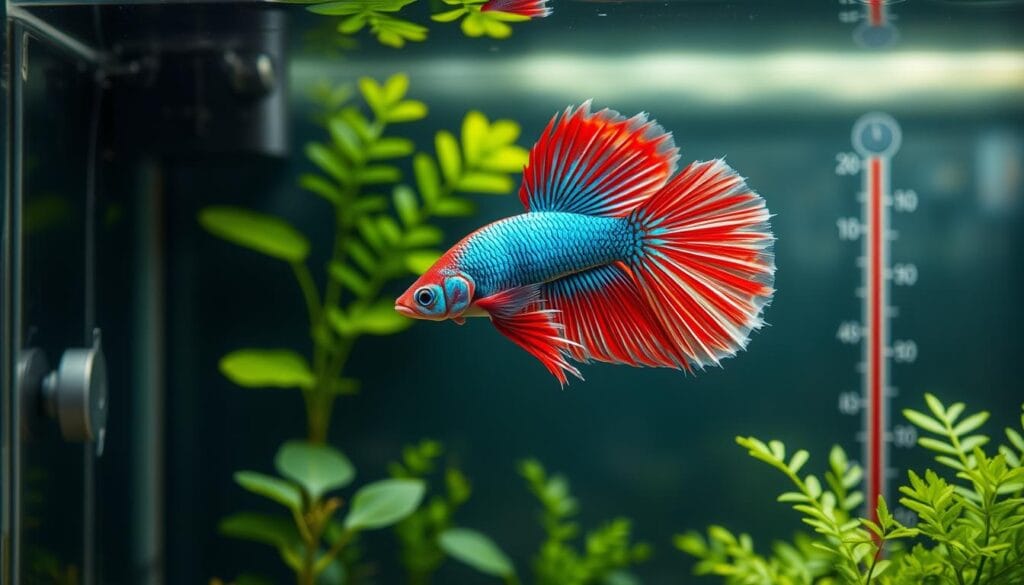
Troubleshooting: When Your Betta Isn’t Building Nests
Wondering why betta fish make bubbles? It’s natural for them to build bubble nests. But, if your betta isn’t doing this, there could be reasons. First, check if your betta is healthy. A healthy betta should build nests.
There are several reasons why your betta might not build nests. Environmental issues like poor water quality or bad tank conditions could be the problem. Age also matters, as younger bettas are more active in building nests. To solve this, consider these factors:
Health-Related Issues
Look for signs of illness or stress in your betta. Signs include labored breathing, being very tired, or not wanting to eat. Make sure your betta eats well and the water is clean.
Environmental Problems
Make sure your tank is big enough for your betta. It should be at least 5 gallons and keep the water between 75-80 °F. You can also try adding plants or changing the water temperature to encourage your betta to build nests.
Age Considerations
Betta fish live about 2-3 years, and their behavior changes with age. If your betta is young, it might take time to start building nests. Older bettas might not be as active in building nests because of their age.
Maintaining Your Tank During Nest Building
When you see bubbles in your betta fish tank, keeping the tank clean is key. Regular water changes and good filtration help prevent sickness and support growth. Aim for weekly water changes of 25% and keep the water temperature between 78 and 81 degrees Fahrenheit.
To keep your betta fish healthy, follow these tips:
- Limit light to 5-8 hours a day for rest.
- Keep the water calm, as betta fish prefer stagnant waters.
- Use a sponge filter for gentle water flow.
Some people keep a filterless 2.5-gallon tank with live plants like Salvinia minima and lily plants. But, always check the water quality and adjust as needed. By keeping the tank clean and healthy, your betta fish can build and maintain bubbles in your betta fish tank, showing they’re in good shape.
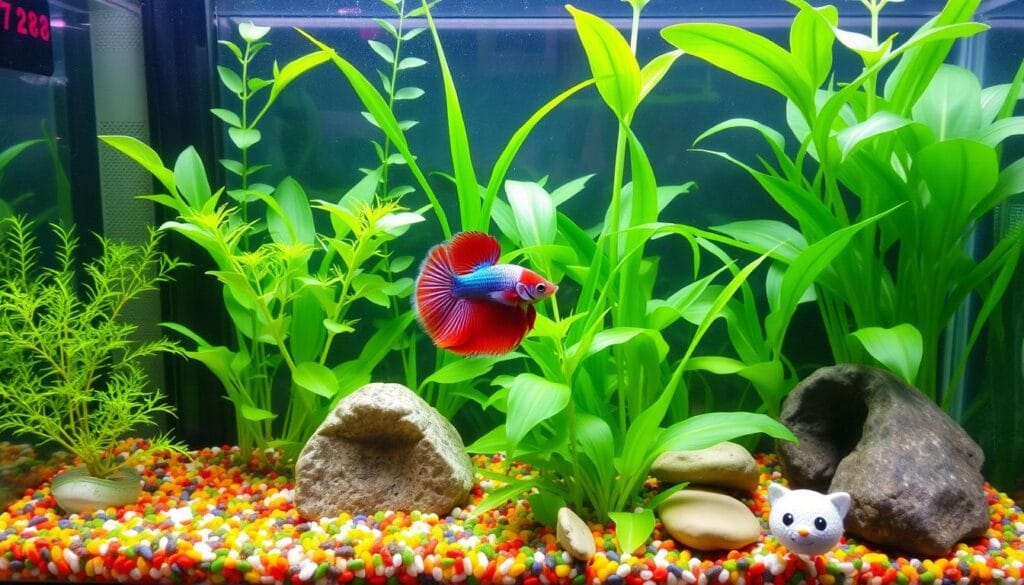
Regularly clean your tank, but be gentle to avoid disturbing your betta fish or the bubbles in your betta fish tank. With the right care, you’ll see your betta fish flourish and build their bubble nests, a sign of health and a strong biological rhythm.
Conclusion: Supporting Your Betta’s Natural Behaviors
A betta fish’s bubble nest is a key part of their natural behavior. Understanding this trait helps you create a better environment for your betta. This lets them show their true nature.
Male bettas usually get ready to nest at 4-6 months old. The best temperature for nesting is 76-82°F (24-28°C). Keeping the water clean is also important for their nesting habits.
Not all male bettas make a bubble nest. But, the right conditions can help. A 5-gallon tank or bigger and calm water are good for nesting. With time and care, you’ll see your betta’s amazing nesting behavior.
FAQ
What exactly is a bubble nest?
A bubble nest is a group of air bubbles on the water’s surface made by male betta fish. These nests are vital for breeding. They offer a safe spot for eggs and baby bettas.
When do bettas start building nests?
Betta fish start building nests when they’re sexually mature, usually between 3-6 months old. This behavior is natural and depends on water quality, temperature, and the presence of a mate.
What are the differences between natural and aquarium nest building?
In the wild, betta fish use plants and debris to build nests. In aquariums, they might use the surface area to create nests. These can be less elaborate than natural nests.
Why do male bettas create bubble nests?
Male bettas build nests for breeding. The nest is safe for the female to lay eggs. The male then fertilizes and cares for the eggs until they hatch. This is a key part of their breeding behavior.
What are the signs of a healthy betta fish bubble nest?
A healthy nest is stable, well-made, and covers a lot of the water’s surface. The bubbles should be the same size and not wet or falling apart. But, a healthy nest doesn’t mean the betta is happy.
What factors contribute to creating the perfect environment for nest building?
For the best nest building, ensure the water quality, temperature, and surface area are right. This means keeping the water clean, at the right temperature, and providing enough space for the nest.
What are some common misconceptions about bubble nests?
Many think bubble nests mean a happy betta. But, they’re mainly about breeding and environmental triggers, not happiness.
Why isn’t my betta fish building a nest?
Reasons include health issues, tank problems, or age. If your betta is healthy, check the tank conditions. Make sure the water is right and there’s enough space for the nest.
How important is maintaining a clean tank during nest building?
Keeping the tank clean is very important during nest building. Regular water changes and good filtration help your betta’s health and nest building.
There are no reviews yet. Be the first one to write one.

